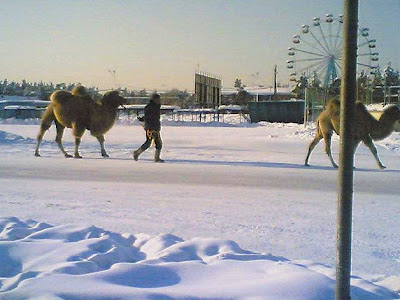 |
| Girls night out in Irkutsk |
6,194 Miles GMT +9 Temp -11
We travelled to Krasnoyarsk on Wednesday
evening, arrived on Thursday afternoon. We were planning on staying there,
however our carriage attendant Anna told us shortly before we arrived that it
was –34 with freezing fog. Even the locals avoid that, so with the train
stopping for around 20 mins, Lena purchased new tickets, Anya went in search of
Chocolate and I took photos of the station mosaic before we jumped back on the
train for the 27 hours journey to Irkutsk.
 |
| Proper cold |
We are now out of Industrial Siberia and at
what is considered to be the gateway to the Far East. We have recently passed
by the Sayan Mountains and through the Altai & Tuvan Republics in the snow.
We saw a few Yurts/Gers and some herding nomads on the way here. For the first
time I realised how far away I am from home, even felt a bit homesick. For the
rest of the journey we will have the Mongolian then Chinese border to our
right, and on the left mostly the Siberian wilderness.
We arrived at Irkutsk on Friday evening.
Thankfully the Hotel Gloria was Glorious – the room was like a real hotel room.
It had carpet on the floor, there was a bath – praise be, the heating works
properly, the staff have stamped our papers for 10 days for free -
bliss. Now I know why Lena loves Siberia.
We went in search of a restaurant just a few
doors away, and met the women in the photo above who invited us to eat with
them, as two of them are learning English. They were just lovely, we shared a
couple of bottles of Mongolian Merlot, and they recommended the Mongolian BBQ,
which was excellent. We were invited to go onto a night spot with them, but we
politely declined, as we’ve been warned about women in fur coats previously.
 |
| We walk dogs, Siberians take their camles out.......... |
We spent Saturday exploring Irkutsk, which is
a truly multi-cultural delight, as well as being the former home of the
Decemberists, a group of Russian folk heroes who I’ve detailed below.
 |
| One of the originl homes built by the Decemberists |
Irkutsk was founded in 1651 as a Cossack
garrison to control the indigenous Buryats. Irkutsk was the springboard for the
18th century expeditions to the far north and east, including
Alaska, then known as Irkutsk’s American district. As Eastern Siberia’s trading
and administrative centre, Irkutsk dispatched Siberian furs and ivory to
Mongolia, Tibet and China, in exchange for silk and tea. A major percentage of
the city was burnt down in 1879, However during the 1880’s there was a large
gold rush in the area and the city was quickly restored and rebuilt. Known as
the ‘Paris of Siberia’, Irkutsk did not welcome news of the October revolution,
the cities well-to-do merchants only succumbed to the red tide in 1920.
Former residents of Irkutsk the
‘Decemberists’, a group of aristocratic, liberal leaning army officers, who had
occupied Senate Sq in St Petersburg, in an ill-conceived coup against Tsar
Nicholas I. The date was December 26th 1825, hence their soubriquet.
The mutineers were poorly organised and outnumbered. After a stand-off which
lasted most of the day, the Tsars troops opened fire, killing about 60 people,
the rebellion crumbled. Five leaders ere executed and the remaining 121 were
sentenced to hard labour, prison and exile in Siberia. They became romantic
heroes of a sort, but the real heroes were their women, many of who abandoned
their lives of comfort and sophistication to follow their husbands or lovers
into exile. The first was Yekaterina Trubestkaya who is alleged to have
travelled 6000 km by coach to Nerchinsk and then on arrival went straight to
the silver mine to find her husband.
Others had to wait for months in Irkutsk or
Chita for permission to see their men, meanwhile setting up small social
circles, and over a period of two decades the exiled families opened schools,
formed scientific societies and edited newspapers.
The Decemberists were granted amnesty when Nicholas
I died in 1855, and while some of them returned to St Petersburg, some remained
and their legacy provided the early infrastructure of the area.
No comments:
Post a Comment